Singapore's Economic Success Factors
VerifiedAdded on 2020/03/04
|14
|3782
|61
AI Summary
This assignment delves into the key drivers behind Singapore's remarkable economic growth. Students will examine the impact of foreign direct investment (FDI), trade policies, a focus on innovation and technology, and the role of special economic zones in shaping Singapore's economic landscape. The analysis draws upon various research papers and reports to provide insights into the country's strategies for sustainable development.
Contribute Materials
Your contribution can guide someone’s learning journey. Share your
documents today.
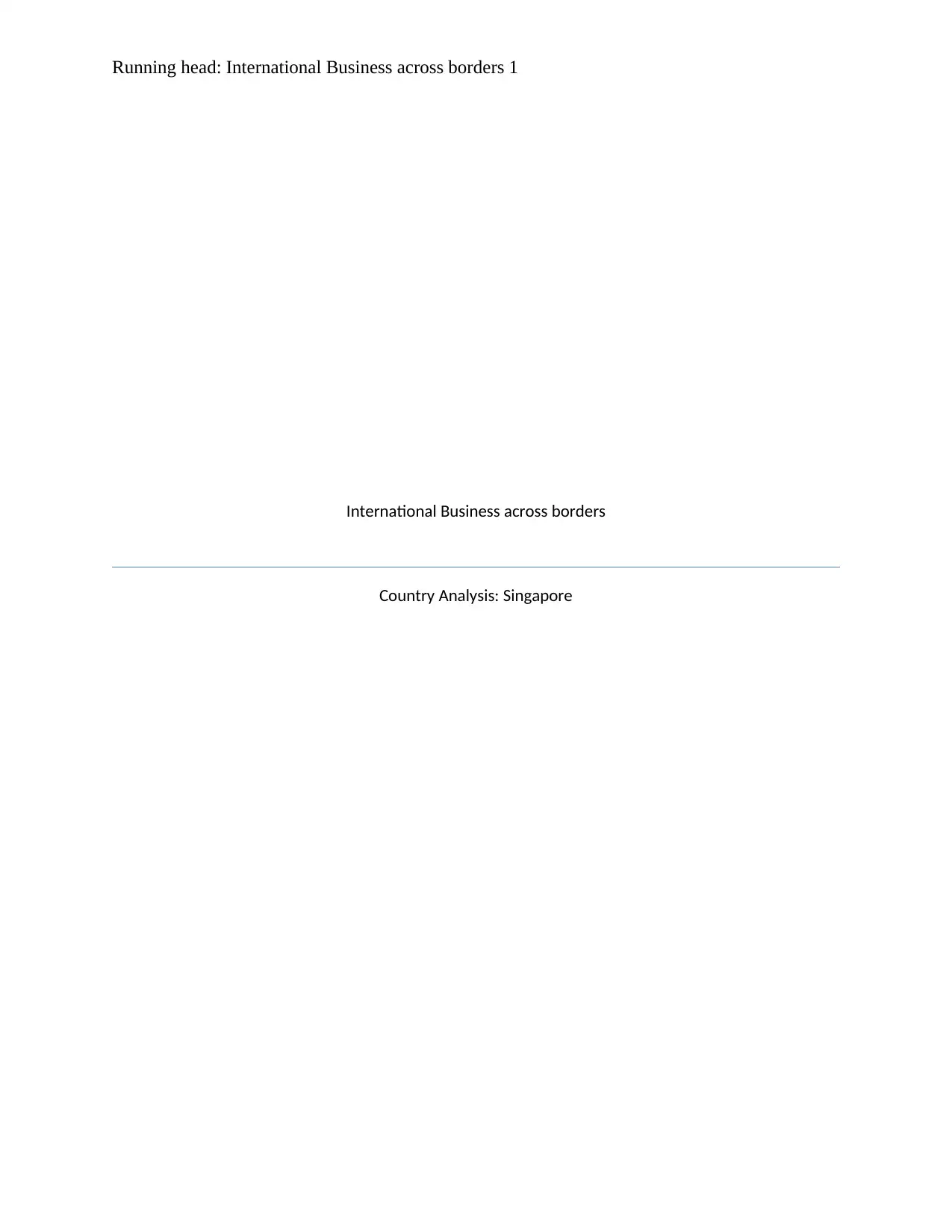
Running head: International Business across borders 1
International Business across borders
Country Analysis: Singapore
International Business across borders
Country Analysis: Singapore
Secure Best Marks with AI Grader
Need help grading? Try our AI Grader for instant feedback on your assignments.
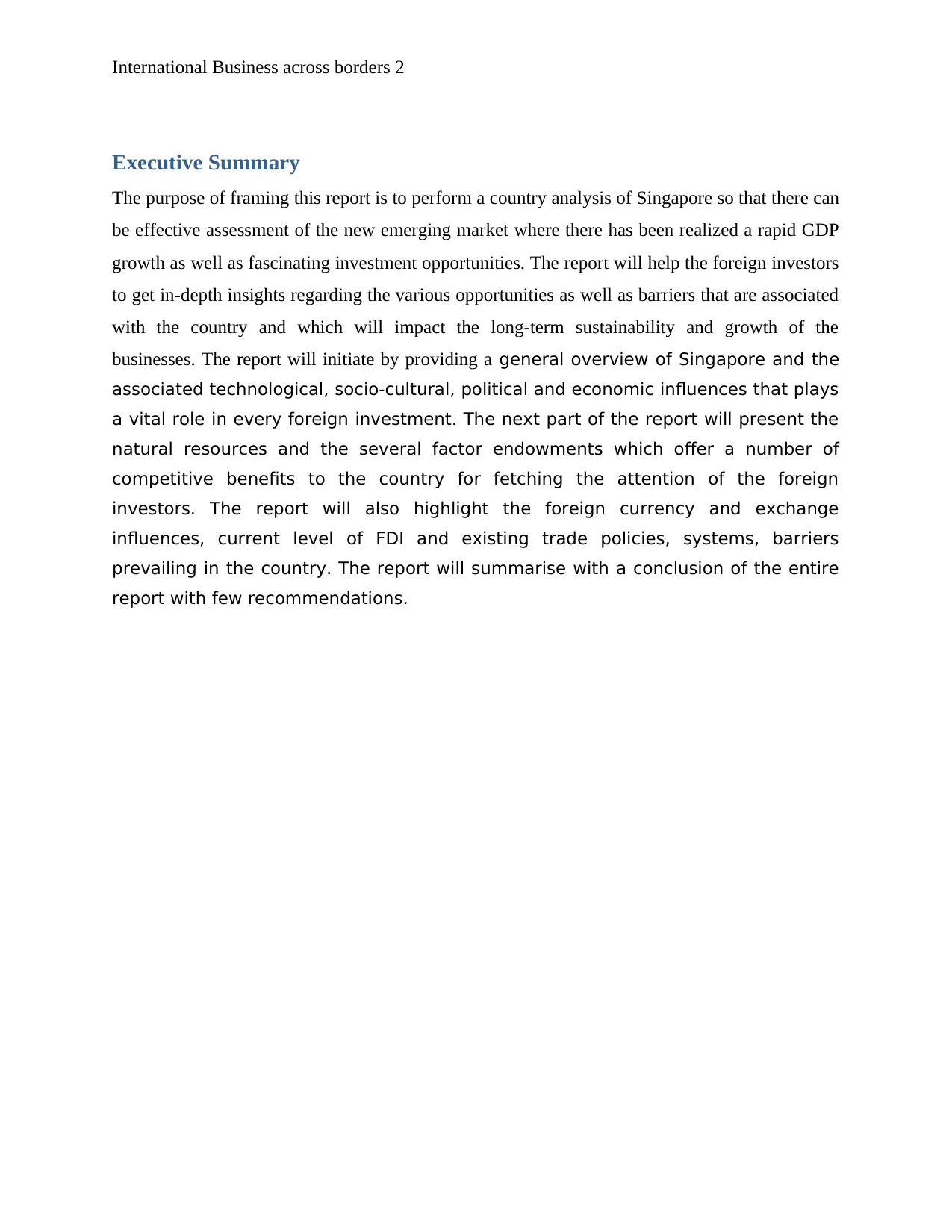
International Business across borders 2
Executive Summary
The purpose of framing this report is to perform a country analysis of Singapore so that there can
be effective assessment of the new emerging market where there has been realized a rapid GDP
growth as well as fascinating investment opportunities. The report will help the foreign investors
to get in-depth insights regarding the various opportunities as well as barriers that are associated
with the country and which will impact the long-term sustainability and growth of the
businesses. The report will initiate by providing a general overview of Singapore and the
associated technological, socio-cultural, political and economic influences that plays
a vital role in every foreign investment. The next part of the report will present the
natural resources and the several factor endowments which offer a number of
competitive benefits to the country for fetching the attention of the foreign
investors. The report will also highlight the foreign currency and exchange
influences, current level of FDI and existing trade policies, systems, barriers
prevailing in the country. The report will summarise with a conclusion of the entire
report with few recommendations.
Executive Summary
The purpose of framing this report is to perform a country analysis of Singapore so that there can
be effective assessment of the new emerging market where there has been realized a rapid GDP
growth as well as fascinating investment opportunities. The report will help the foreign investors
to get in-depth insights regarding the various opportunities as well as barriers that are associated
with the country and which will impact the long-term sustainability and growth of the
businesses. The report will initiate by providing a general overview of Singapore and the
associated technological, socio-cultural, political and economic influences that plays
a vital role in every foreign investment. The next part of the report will present the
natural resources and the several factor endowments which offer a number of
competitive benefits to the country for fetching the attention of the foreign
investors. The report will also highlight the foreign currency and exchange
influences, current level of FDI and existing trade policies, systems, barriers
prevailing in the country. The report will summarise with a conclusion of the entire
report with few recommendations.
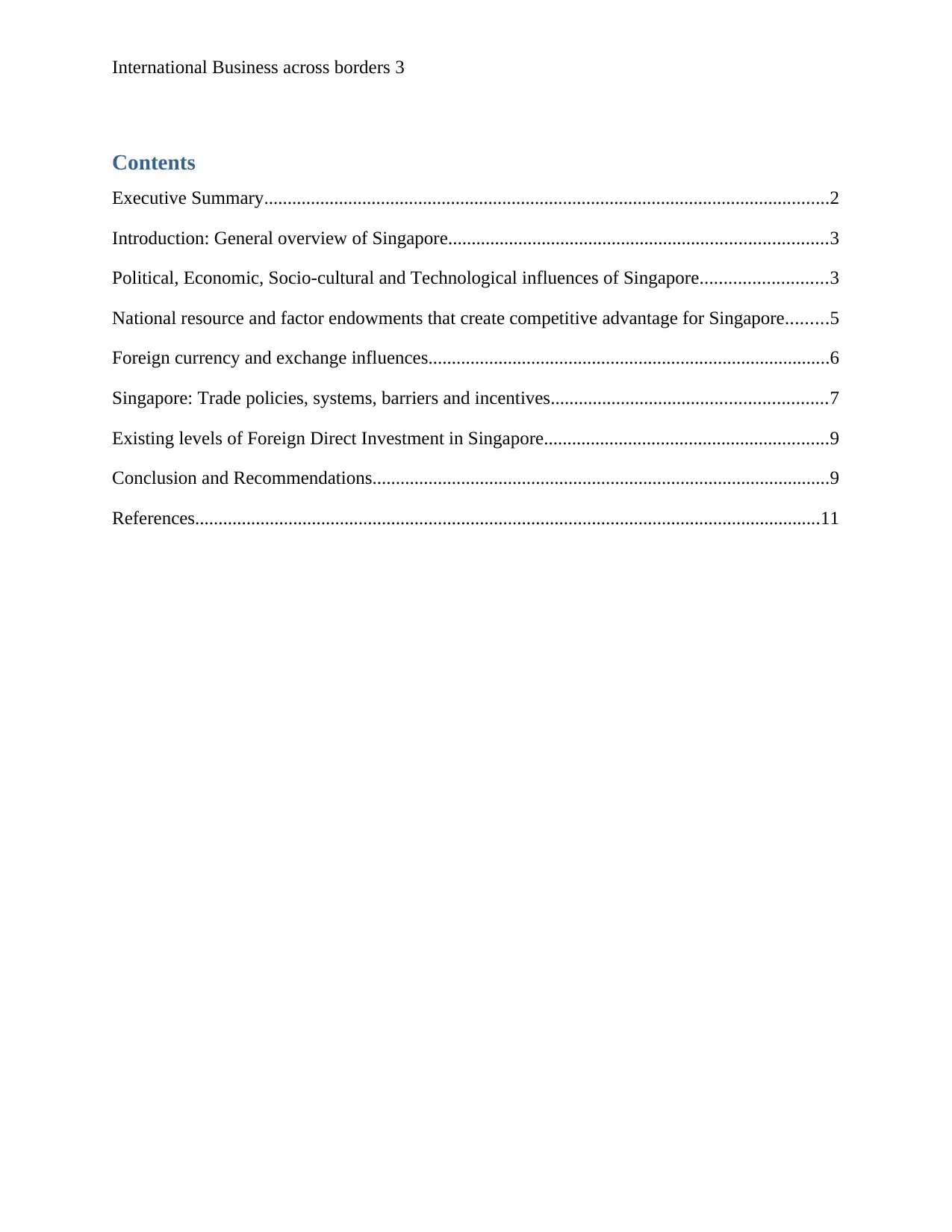
International Business across borders 3
Contents
Executive Summary.........................................................................................................................2
Introduction: General overview of Singapore.................................................................................3
Political, Economic, Socio-cultural and Technological influences of Singapore...........................3
National resource and factor endowments that create competitive advantage for Singapore.........5
Foreign currency and exchange influences......................................................................................6
Singapore: Trade policies, systems, barriers and incentives...........................................................7
Existing levels of Foreign Direct Investment in Singapore.............................................................9
Conclusion and Recommendations..................................................................................................9
References......................................................................................................................................11
Contents
Executive Summary.........................................................................................................................2
Introduction: General overview of Singapore.................................................................................3
Political, Economic, Socio-cultural and Technological influences of Singapore...........................3
National resource and factor endowments that create competitive advantage for Singapore.........5
Foreign currency and exchange influences......................................................................................6
Singapore: Trade policies, systems, barriers and incentives...........................................................7
Existing levels of Foreign Direct Investment in Singapore.............................................................9
Conclusion and Recommendations..................................................................................................9
References......................................................................................................................................11
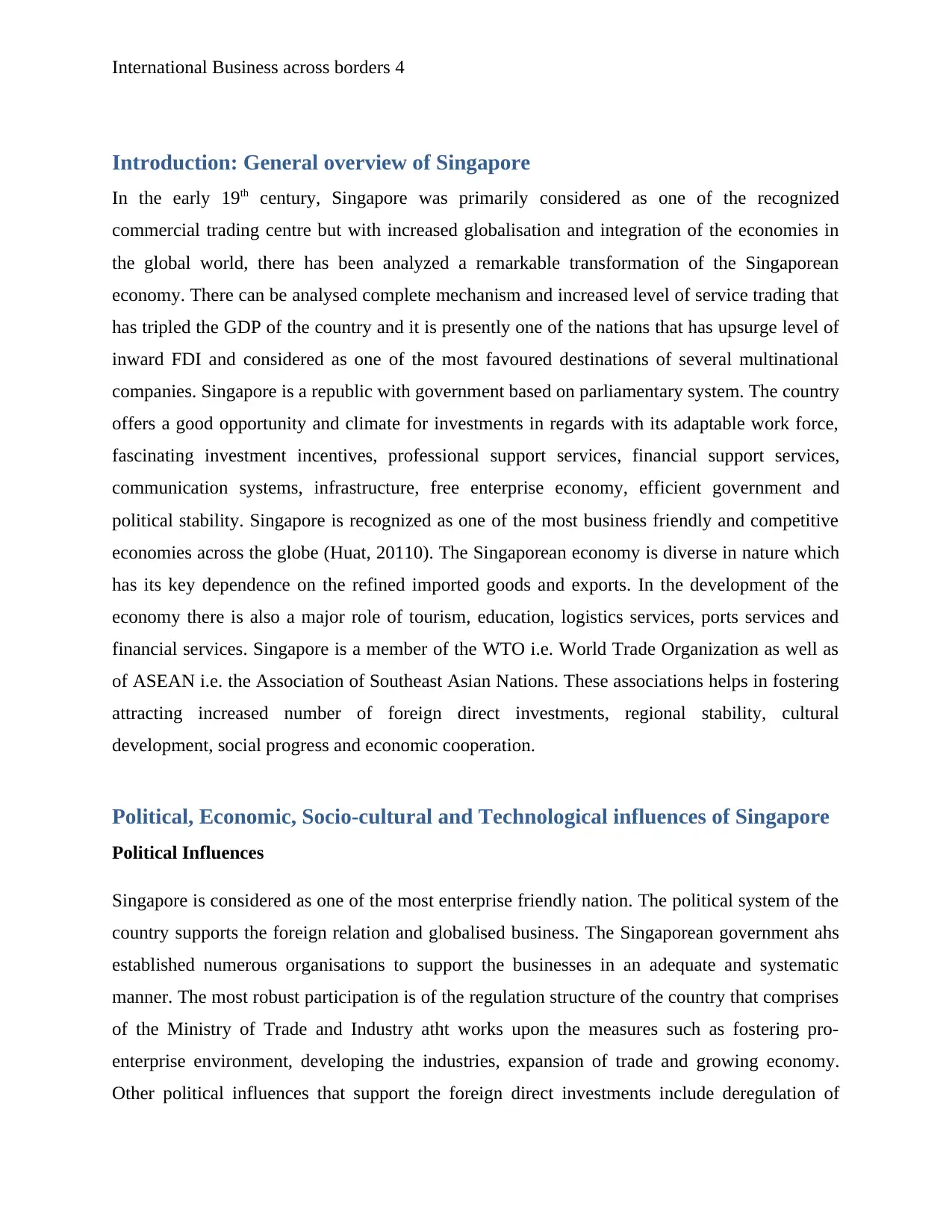
International Business across borders 4
Introduction: General overview of Singapore
In the early 19th century, Singapore was primarily considered as one of the recognized
commercial trading centre but with increased globalisation and integration of the economies in
the global world, there has been analyzed a remarkable transformation of the Singaporean
economy. There can be analysed complete mechanism and increased level of service trading that
has tripled the GDP of the country and it is presently one of the nations that has upsurge level of
inward FDI and considered as one of the most favoured destinations of several multinational
companies. Singapore is a republic with government based on parliamentary system. The country
offers a good opportunity and climate for investments in regards with its adaptable work force,
fascinating investment incentives, professional support services, financial support services,
communication systems, infrastructure, free enterprise economy, efficient government and
political stability. Singapore is recognized as one of the most business friendly and competitive
economies across the globe (Huat, 20110). The Singaporean economy is diverse in nature which
has its key dependence on the refined imported goods and exports. In the development of the
economy there is also a major role of tourism, education, logistics services, ports services and
financial services. Singapore is a member of the WTO i.e. World Trade Organization as well as
of ASEAN i.e. the Association of Southeast Asian Nations. These associations helps in fostering
attracting increased number of foreign direct investments, regional stability, cultural
development, social progress and economic cooperation.
Political, Economic, Socio-cultural and Technological influences of Singapore
Political Influences
Singapore is considered as one of the most enterprise friendly nation. The political system of the
country supports the foreign relation and globalised business. The Singaporean government ahs
established numerous organisations to support the businesses in an adequate and systematic
manner. The most robust participation is of the regulation structure of the country that comprises
of the Ministry of Trade and Industry atht works upon the measures such as fostering pro-
enterprise environment, developing the industries, expansion of trade and growing economy.
Other political influences that support the foreign direct investments include deregulation of
Introduction: General overview of Singapore
In the early 19th century, Singapore was primarily considered as one of the recognized
commercial trading centre but with increased globalisation and integration of the economies in
the global world, there has been analyzed a remarkable transformation of the Singaporean
economy. There can be analysed complete mechanism and increased level of service trading that
has tripled the GDP of the country and it is presently one of the nations that has upsurge level of
inward FDI and considered as one of the most favoured destinations of several multinational
companies. Singapore is a republic with government based on parliamentary system. The country
offers a good opportunity and climate for investments in regards with its adaptable work force,
fascinating investment incentives, professional support services, financial support services,
communication systems, infrastructure, free enterprise economy, efficient government and
political stability. Singapore is recognized as one of the most business friendly and competitive
economies across the globe (Huat, 20110). The Singaporean economy is diverse in nature which
has its key dependence on the refined imported goods and exports. In the development of the
economy there is also a major role of tourism, education, logistics services, ports services and
financial services. Singapore is a member of the WTO i.e. World Trade Organization as well as
of ASEAN i.e. the Association of Southeast Asian Nations. These associations helps in fostering
attracting increased number of foreign direct investments, regional stability, cultural
development, social progress and economic cooperation.
Political, Economic, Socio-cultural and Technological influences of Singapore
Political Influences
Singapore is considered as one of the most enterprise friendly nation. The political system of the
country supports the foreign relation and globalised business. The Singaporean government ahs
established numerous organisations to support the businesses in an adequate and systematic
manner. The most robust participation is of the regulation structure of the country that comprises
of the Ministry of Trade and Industry atht works upon the measures such as fostering pro-
enterprise environment, developing the industries, expansion of trade and growing economy.
Other political influences that support the foreign direct investments include deregulation of
Secure Best Marks with AI Grader
Need help grading? Try our AI Grader for instant feedback on your assignments.
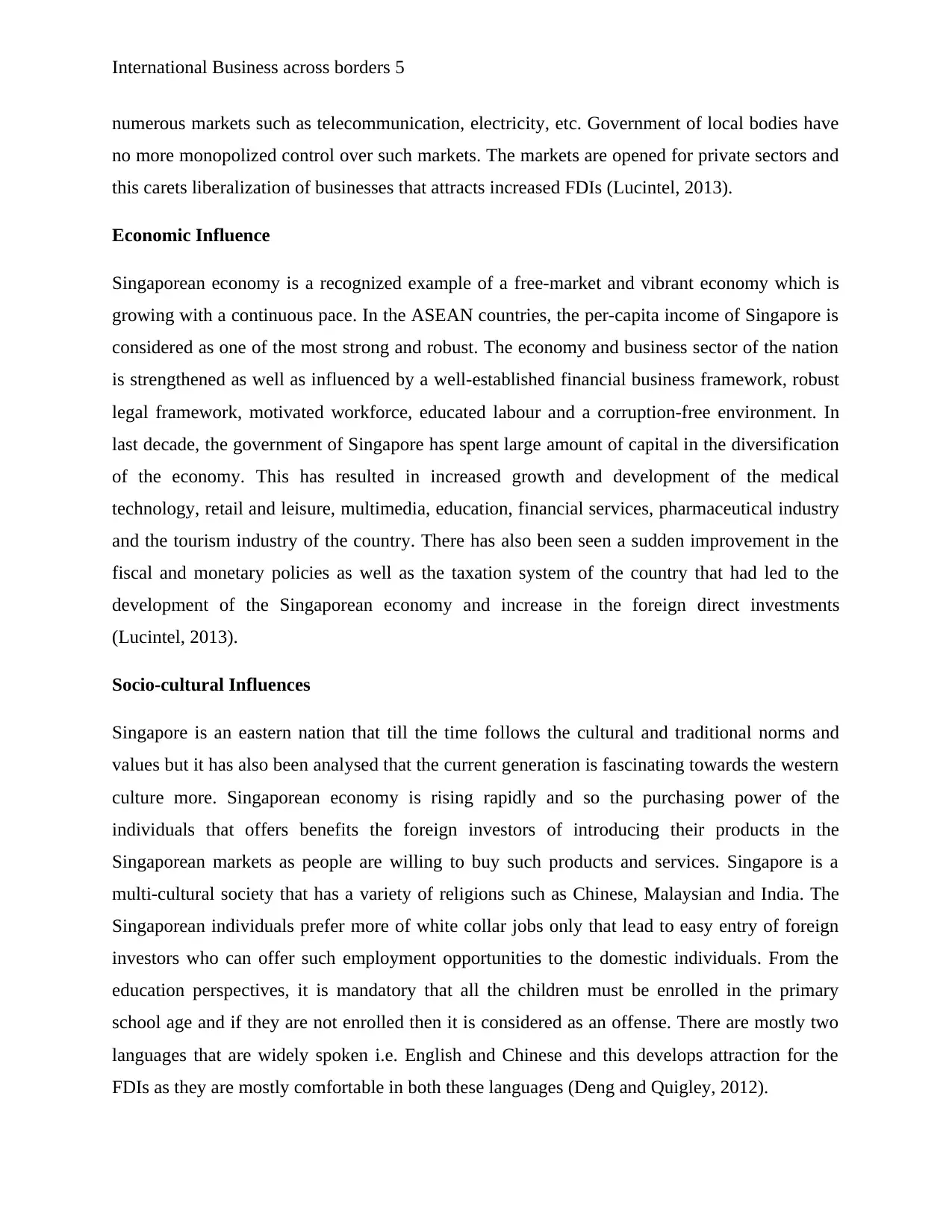
International Business across borders 5
numerous markets such as telecommunication, electricity, etc. Government of local bodies have
no more monopolized control over such markets. The markets are opened for private sectors and
this carets liberalization of businesses that attracts increased FDIs (Lucintel, 2013).
Economic Influence
Singaporean economy is a recognized example of a free-market and vibrant economy which is
growing with a continuous pace. In the ASEAN countries, the per-capita income of Singapore is
considered as one of the most strong and robust. The economy and business sector of the nation
is strengthened as well as influenced by a well-established financial business framework, robust
legal framework, motivated workforce, educated labour and a corruption-free environment. In
last decade, the government of Singapore has spent large amount of capital in the diversification
of the economy. This has resulted in increased growth and development of the medical
technology, retail and leisure, multimedia, education, financial services, pharmaceutical industry
and the tourism industry of the country. There has also been seen a sudden improvement in the
fiscal and monetary policies as well as the taxation system of the country that had led to the
development of the Singaporean economy and increase in the foreign direct investments
(Lucintel, 2013).
Socio-cultural Influences
Singapore is an eastern nation that till the time follows the cultural and traditional norms and
values but it has also been analysed that the current generation is fascinating towards the western
culture more. Singaporean economy is rising rapidly and so the purchasing power of the
individuals that offers benefits the foreign investors of introducing their products in the
Singaporean markets as people are willing to buy such products and services. Singapore is a
multi-cultural society that has a variety of religions such as Chinese, Malaysian and India. The
Singaporean individuals prefer more of white collar jobs only that lead to easy entry of foreign
investors who can offer such employment opportunities to the domestic individuals. From the
education perspectives, it is mandatory that all the children must be enrolled in the primary
school age and if they are not enrolled then it is considered as an offense. There are mostly two
languages that are widely spoken i.e. English and Chinese and this develops attraction for the
FDIs as they are mostly comfortable in both these languages (Deng and Quigley, 2012).
numerous markets such as telecommunication, electricity, etc. Government of local bodies have
no more monopolized control over such markets. The markets are opened for private sectors and
this carets liberalization of businesses that attracts increased FDIs (Lucintel, 2013).
Economic Influence
Singaporean economy is a recognized example of a free-market and vibrant economy which is
growing with a continuous pace. In the ASEAN countries, the per-capita income of Singapore is
considered as one of the most strong and robust. The economy and business sector of the nation
is strengthened as well as influenced by a well-established financial business framework, robust
legal framework, motivated workforce, educated labour and a corruption-free environment. In
last decade, the government of Singapore has spent large amount of capital in the diversification
of the economy. This has resulted in increased growth and development of the medical
technology, retail and leisure, multimedia, education, financial services, pharmaceutical industry
and the tourism industry of the country. There has also been seen a sudden improvement in the
fiscal and monetary policies as well as the taxation system of the country that had led to the
development of the Singaporean economy and increase in the foreign direct investments
(Lucintel, 2013).
Socio-cultural Influences
Singapore is an eastern nation that till the time follows the cultural and traditional norms and
values but it has also been analysed that the current generation is fascinating towards the western
culture more. Singaporean economy is rising rapidly and so the purchasing power of the
individuals that offers benefits the foreign investors of introducing their products in the
Singaporean markets as people are willing to buy such products and services. Singapore is a
multi-cultural society that has a variety of religions such as Chinese, Malaysian and India. The
Singaporean individuals prefer more of white collar jobs only that lead to easy entry of foreign
investors who can offer such employment opportunities to the domestic individuals. From the
education perspectives, it is mandatory that all the children must be enrolled in the primary
school age and if they are not enrolled then it is considered as an offense. There are mostly two
languages that are widely spoken i.e. English and Chinese and this develops attraction for the
FDIs as they are mostly comfortable in both these languages (Deng and Quigley, 2012).
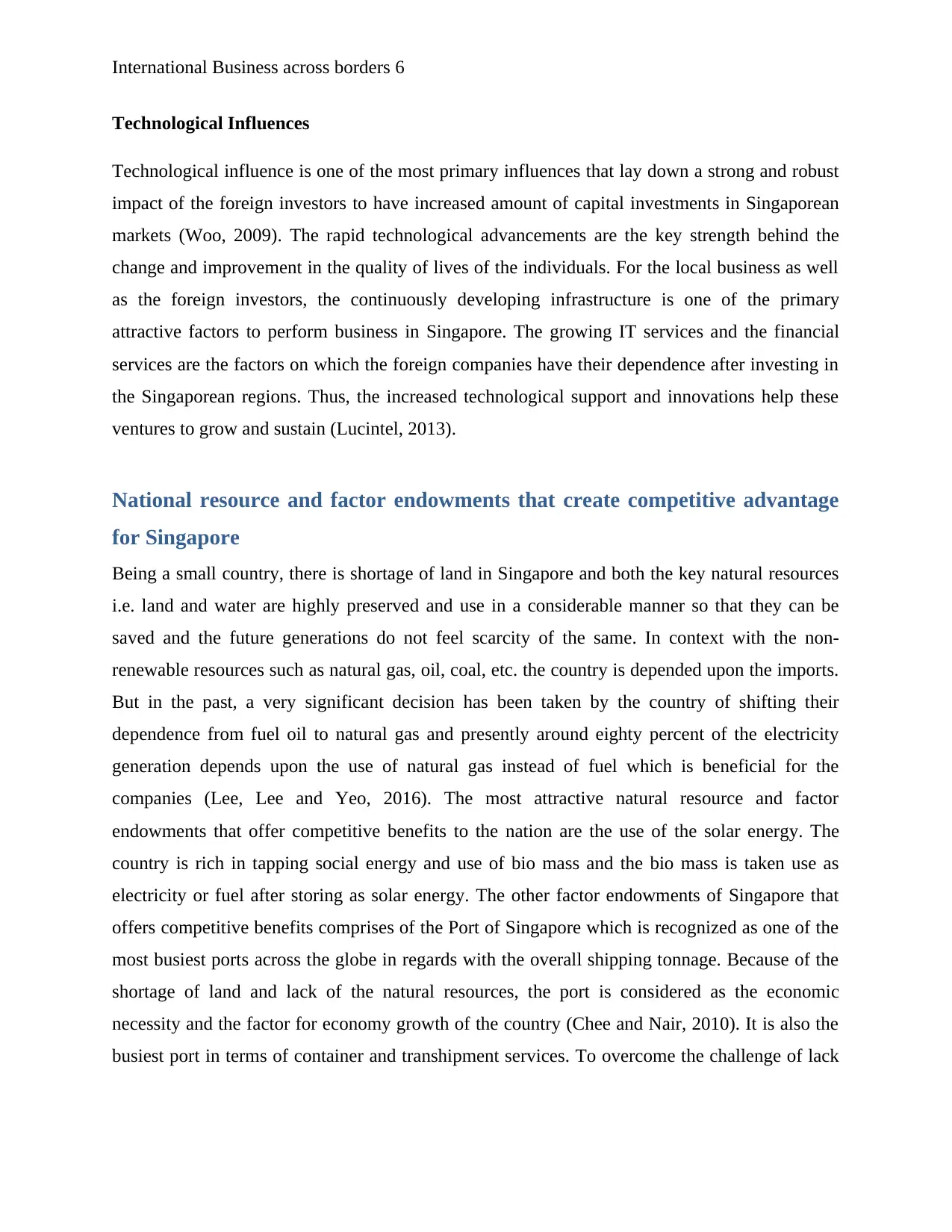
International Business across borders 6
Technological Influences
Technological influence is one of the most primary influences that lay down a strong and robust
impact of the foreign investors to have increased amount of capital investments in Singaporean
markets (Woo, 2009). The rapid technological advancements are the key strength behind the
change and improvement in the quality of lives of the individuals. For the local business as well
as the foreign investors, the continuously developing infrastructure is one of the primary
attractive factors to perform business in Singapore. The growing IT services and the financial
services are the factors on which the foreign companies have their dependence after investing in
the Singaporean regions. Thus, the increased technological support and innovations help these
ventures to grow and sustain (Lucintel, 2013).
National resource and factor endowments that create competitive advantage
for Singapore
Being a small country, there is shortage of land in Singapore and both the key natural resources
i.e. land and water are highly preserved and use in a considerable manner so that they can be
saved and the future generations do not feel scarcity of the same. In context with the non-
renewable resources such as natural gas, oil, coal, etc. the country is depended upon the imports.
But in the past, a very significant decision has been taken by the country of shifting their
dependence from fuel oil to natural gas and presently around eighty percent of the electricity
generation depends upon the use of natural gas instead of fuel which is beneficial for the
companies (Lee, Lee and Yeo, 2016). The most attractive natural resource and factor
endowments that offer competitive benefits to the nation are the use of the solar energy. The
country is rich in tapping social energy and use of bio mass and the bio mass is taken use as
electricity or fuel after storing as solar energy. The other factor endowments of Singapore that
offers competitive benefits comprises of the Port of Singapore which is recognized as one of the
most busiest ports across the globe in regards with the overall shipping tonnage. Because of the
shortage of land and lack of the natural resources, the port is considered as the economic
necessity and the factor for economy growth of the country (Chee and Nair, 2010). It is also the
busiest port in terms of container and transhipment services. To overcome the challenge of lack
Technological Influences
Technological influence is one of the most primary influences that lay down a strong and robust
impact of the foreign investors to have increased amount of capital investments in Singaporean
markets (Woo, 2009). The rapid technological advancements are the key strength behind the
change and improvement in the quality of lives of the individuals. For the local business as well
as the foreign investors, the continuously developing infrastructure is one of the primary
attractive factors to perform business in Singapore. The growing IT services and the financial
services are the factors on which the foreign companies have their dependence after investing in
the Singaporean regions. Thus, the increased technological support and innovations help these
ventures to grow and sustain (Lucintel, 2013).
National resource and factor endowments that create competitive advantage
for Singapore
Being a small country, there is shortage of land in Singapore and both the key natural resources
i.e. land and water are highly preserved and use in a considerable manner so that they can be
saved and the future generations do not feel scarcity of the same. In context with the non-
renewable resources such as natural gas, oil, coal, etc. the country is depended upon the imports.
But in the past, a very significant decision has been taken by the country of shifting their
dependence from fuel oil to natural gas and presently around eighty percent of the electricity
generation depends upon the use of natural gas instead of fuel which is beneficial for the
companies (Lee, Lee and Yeo, 2016). The most attractive natural resource and factor
endowments that offer competitive benefits to the nation are the use of the solar energy. The
country is rich in tapping social energy and use of bio mass and the bio mass is taken use as
electricity or fuel after storing as solar energy. The other factor endowments of Singapore that
offers competitive benefits comprises of the Port of Singapore which is recognized as one of the
most busiest ports across the globe in regards with the overall shipping tonnage. Because of the
shortage of land and lack of the natural resources, the port is considered as the economic
necessity and the factor for economy growth of the country (Chee and Nair, 2010). It is also the
busiest port in terms of container and transhipment services. To overcome the challenge of lack
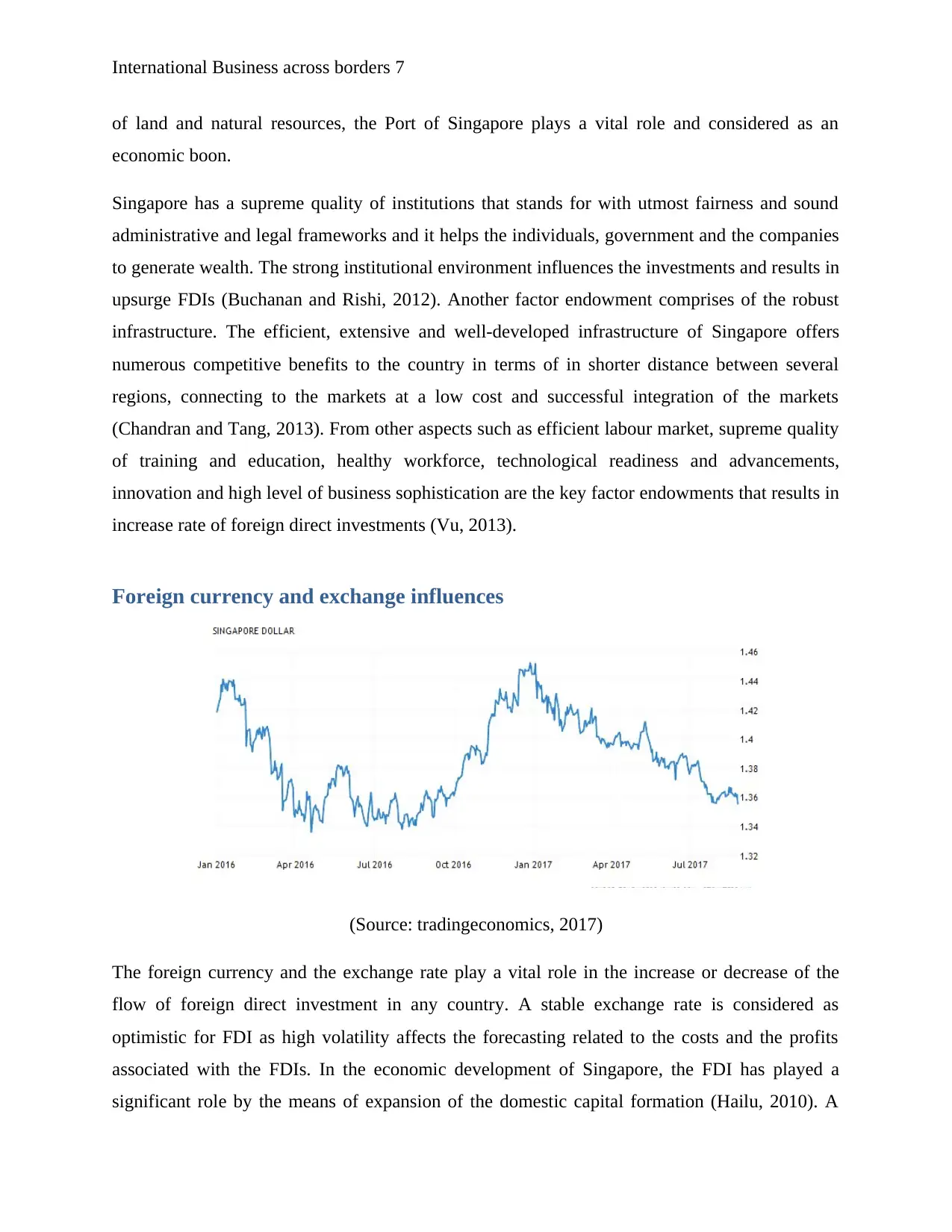
International Business across borders 7
of land and natural resources, the Port of Singapore plays a vital role and considered as an
economic boon.
Singapore has a supreme quality of institutions that stands for with utmost fairness and sound
administrative and legal frameworks and it helps the individuals, government and the companies
to generate wealth. The strong institutional environment influences the investments and results in
upsurge FDIs (Buchanan and Rishi, 2012). Another factor endowment comprises of the robust
infrastructure. The efficient, extensive and well-developed infrastructure of Singapore offers
numerous competitive benefits to the country in terms of in shorter distance between several
regions, connecting to the markets at a low cost and successful integration of the markets
(Chandran and Tang, 2013). From other aspects such as efficient labour market, supreme quality
of training and education, healthy workforce, technological readiness and advancements,
innovation and high level of business sophistication are the key factor endowments that results in
increase rate of foreign direct investments (Vu, 2013).
Foreign currency and exchange influences
(Source: tradingeconomics, 2017)
The foreign currency and the exchange rate play a vital role in the increase or decrease of the
flow of foreign direct investment in any country. A stable exchange rate is considered as
optimistic for FDI as high volatility affects the forecasting related to the costs and the profits
associated with the FDIs. In the economic development of Singapore, the FDI has played a
significant role by the means of expansion of the domestic capital formation (Hailu, 2010). A
of land and natural resources, the Port of Singapore plays a vital role and considered as an
economic boon.
Singapore has a supreme quality of institutions that stands for with utmost fairness and sound
administrative and legal frameworks and it helps the individuals, government and the companies
to generate wealth. The strong institutional environment influences the investments and results in
upsurge FDIs (Buchanan and Rishi, 2012). Another factor endowment comprises of the robust
infrastructure. The efficient, extensive and well-developed infrastructure of Singapore offers
numerous competitive benefits to the country in terms of in shorter distance between several
regions, connecting to the markets at a low cost and successful integration of the markets
(Chandran and Tang, 2013). From other aspects such as efficient labour market, supreme quality
of training and education, healthy workforce, technological readiness and advancements,
innovation and high level of business sophistication are the key factor endowments that results in
increase rate of foreign direct investments (Vu, 2013).
Foreign currency and exchange influences
(Source: tradingeconomics, 2017)
The foreign currency and the exchange rate play a vital role in the increase or decrease of the
flow of foreign direct investment in any country. A stable exchange rate is considered as
optimistic for FDI as high volatility affects the forecasting related to the costs and the profits
associated with the FDIs. In the economic development of Singapore, the FDI has played a
significant role by the means of expansion of the domestic capital formation (Hailu, 2010). A
Paraphrase This Document
Need a fresh take? Get an instant paraphrase of this document with our AI Paraphraser
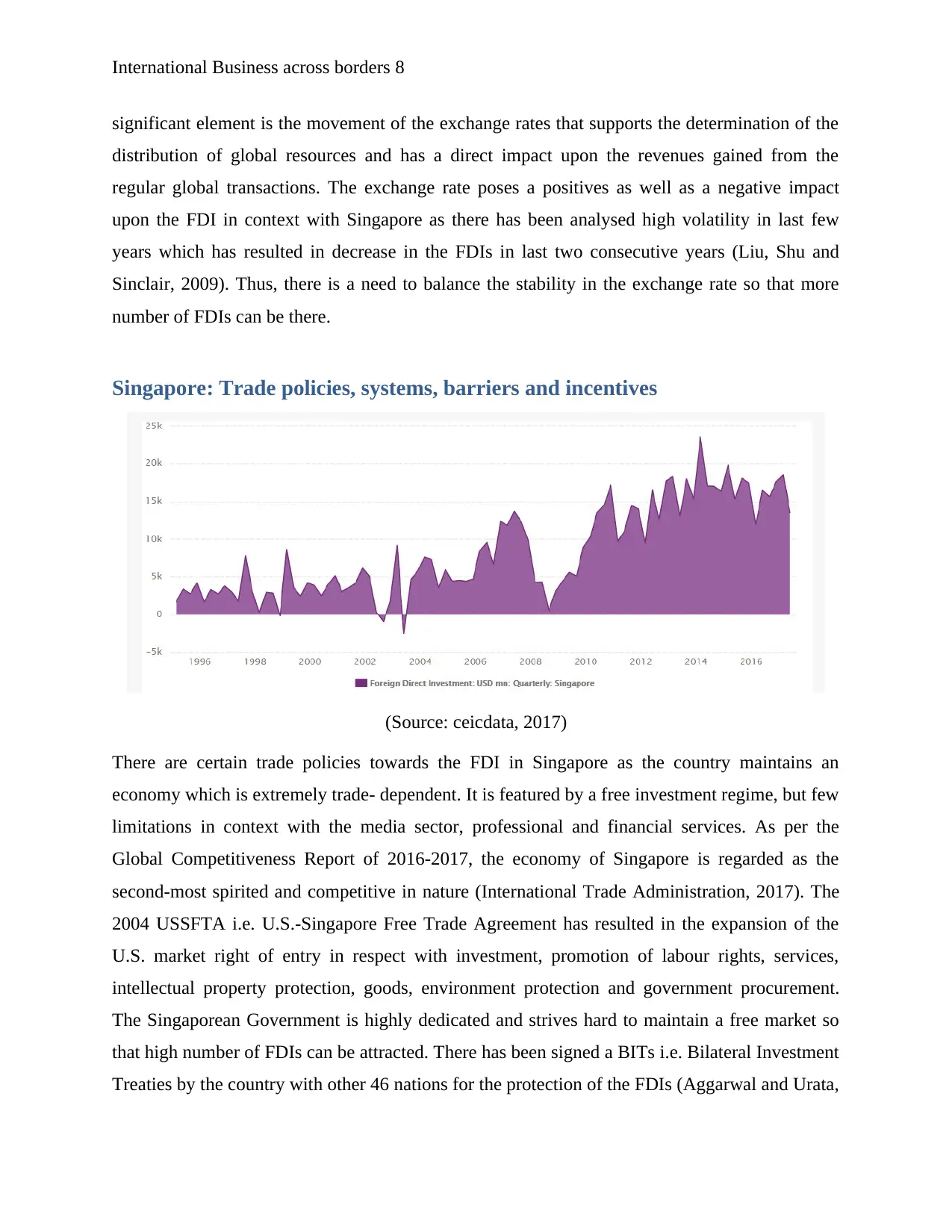
International Business across borders 8
significant element is the movement of the exchange rates that supports the determination of the
distribution of global resources and has a direct impact upon the revenues gained from the
regular global transactions. The exchange rate poses a positives as well as a negative impact
upon the FDI in context with Singapore as there has been analysed high volatility in last few
years which has resulted in decrease in the FDIs in last two consecutive years (Liu, Shu and
Sinclair, 2009). Thus, there is a need to balance the stability in the exchange rate so that more
number of FDIs can be there.
Singapore: Trade policies, systems, barriers and incentives
(Source: ceicdata, 2017)
There are certain trade policies towards the FDI in Singapore as the country maintains an
economy which is extremely trade- dependent. It is featured by a free investment regime, but few
limitations in context with the media sector, professional and financial services. As per the
Global Competitiveness Report of 2016-2017, the economy of Singapore is regarded as the
second-most spirited and competitive in nature (International Trade Administration, 2017). The
2004 USSFTA i.e. U.S.-Singapore Free Trade Agreement has resulted in the expansion of the
U.S. market right of entry in respect with investment, promotion of labour rights, services,
intellectual property protection, goods, environment protection and government procurement.
The Singaporean Government is highly dedicated and strives hard to maintain a free market so
that high number of FDIs can be attracted. There has been signed a BITs i.e. Bilateral Investment
Treaties by the country with other 46 nations for the protection of the FDIs (Aggarwal and Urata,
significant element is the movement of the exchange rates that supports the determination of the
distribution of global resources and has a direct impact upon the revenues gained from the
regular global transactions. The exchange rate poses a positives as well as a negative impact
upon the FDI in context with Singapore as there has been analysed high volatility in last few
years which has resulted in decrease in the FDIs in last two consecutive years (Liu, Shu and
Sinclair, 2009). Thus, there is a need to balance the stability in the exchange rate so that more
number of FDIs can be there.
Singapore: Trade policies, systems, barriers and incentives
(Source: ceicdata, 2017)
There are certain trade policies towards the FDI in Singapore as the country maintains an
economy which is extremely trade- dependent. It is featured by a free investment regime, but few
limitations in context with the media sector, professional and financial services. As per the
Global Competitiveness Report of 2016-2017, the economy of Singapore is regarded as the
second-most spirited and competitive in nature (International Trade Administration, 2017). The
2004 USSFTA i.e. U.S.-Singapore Free Trade Agreement has resulted in the expansion of the
U.S. market right of entry in respect with investment, promotion of labour rights, services,
intellectual property protection, goods, environment protection and government procurement.
The Singaporean Government is highly dedicated and strives hard to maintain a free market so
that high number of FDIs can be attracted. There has been signed a BITs i.e. Bilateral Investment
Treaties by the country with other 46 nations for the protection of the FDIs (Aggarwal and Urata,

International Business across borders 9
2013). As well as the most favoured policy is that there are no laws which abide the foreign
investors for transferring the control or the ownership to the regional interest and thus there are
no disputes occur for the same (International Trade Administration, 2017).
The legal framework, systems and the public policies are considerably favourable for the foreign
investors as they are not required to participate in the joint ventures or having key management
control of the domestic investors as well as the laws are also same for both the domestic and the
foreign investors. Except for some of the sectors mentioned above, the Government of Singapore
analyse all the proposals of investment with the aim of deciding the eligibility for several
incentive regimes. There has been no imposition of restrictions or barricades on the repatriation
of earnings or reinvestments (Alfaro, Kalemli‐Ozcan and Sayek, 2009). The robust judicial
system that comprises of the commercial court, mediation centres and international arbitration
strongly support the contracts’ sanctity and thus there is increased level of transparency that
supports increased number of foreign direct investments. In the Articles of Incorporation under
the Singapore law there is mentioned shareholding limits which confine the possession and rights
in the companies by the foreign partners.
There are several incentives that fetch the attention of the foreign investors to perform business
in Singapore such as the strong financial, robust transport infrastructure, excellent
telecommunications, easy and accessible loan conditions that boost investment incentives, big
markets, strategic locations and efficient maritime routes. Thus, all such are the key benefits to
perform business and invest in Singapore (Wahid, Sawkut and Seetanah, 2009). The government
also promotes incentives by offering tax concessions or incentives to the corporations once they
have been registered within the Singapore’s Economic Development Board. There are few
barricades to such as monopoly and restricted entry in the sectors such as telecommunications,
financial services, media and the professional services. There is a wide role of the Government-
linked corporations that restricts the entry and possession of the foreign investors on few of the
restricted sectors (Farole and Akinci, 2011).
2013). As well as the most favoured policy is that there are no laws which abide the foreign
investors for transferring the control or the ownership to the regional interest and thus there are
no disputes occur for the same (International Trade Administration, 2017).
The legal framework, systems and the public policies are considerably favourable for the foreign
investors as they are not required to participate in the joint ventures or having key management
control of the domestic investors as well as the laws are also same for both the domestic and the
foreign investors. Except for some of the sectors mentioned above, the Government of Singapore
analyse all the proposals of investment with the aim of deciding the eligibility for several
incentive regimes. There has been no imposition of restrictions or barricades on the repatriation
of earnings or reinvestments (Alfaro, Kalemli‐Ozcan and Sayek, 2009). The robust judicial
system that comprises of the commercial court, mediation centres and international arbitration
strongly support the contracts’ sanctity and thus there is increased level of transparency that
supports increased number of foreign direct investments. In the Articles of Incorporation under
the Singapore law there is mentioned shareholding limits which confine the possession and rights
in the companies by the foreign partners.
There are several incentives that fetch the attention of the foreign investors to perform business
in Singapore such as the strong financial, robust transport infrastructure, excellent
telecommunications, easy and accessible loan conditions that boost investment incentives, big
markets, strategic locations and efficient maritime routes. Thus, all such are the key benefits to
perform business and invest in Singapore (Wahid, Sawkut and Seetanah, 2009). The government
also promotes incentives by offering tax concessions or incentives to the corporations once they
have been registered within the Singapore’s Economic Development Board. There are few
barricades to such as monopoly and restricted entry in the sectors such as telecommunications,
financial services, media and the professional services. There is a wide role of the Government-
linked corporations that restricts the entry and possession of the foreign investors on few of the
restricted sectors (Farole and Akinci, 2011).
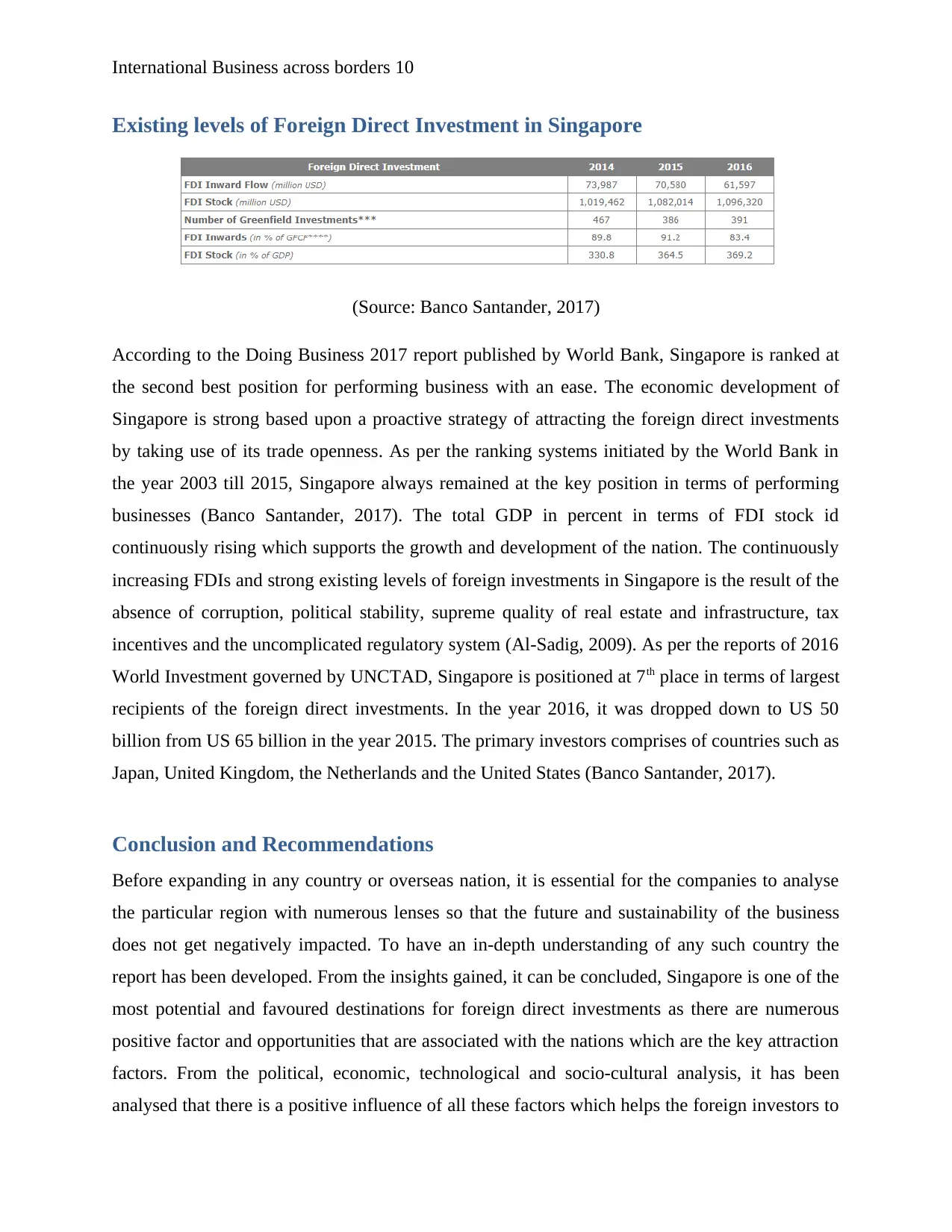
International Business across borders 10
Existing levels of Foreign Direct Investment in Singapore
(Source: Banco Santander, 2017)
According to the Doing Business 2017 report published by World Bank, Singapore is ranked at
the second best position for performing business with an ease. The economic development of
Singapore is strong based upon a proactive strategy of attracting the foreign direct investments
by taking use of its trade openness. As per the ranking systems initiated by the World Bank in
the year 2003 till 2015, Singapore always remained at the key position in terms of performing
businesses (Banco Santander, 2017). The total GDP in percent in terms of FDI stock id
continuously rising which supports the growth and development of the nation. The continuously
increasing FDIs and strong existing levels of foreign investments in Singapore is the result of the
absence of corruption, political stability, supreme quality of real estate and infrastructure, tax
incentives and the uncomplicated regulatory system (Al-Sadig, 2009). As per the reports of 2016
World Investment governed by UNCTAD, Singapore is positioned at 7th place in terms of largest
recipients of the foreign direct investments. In the year 2016, it was dropped down to US 50
billion from US 65 billion in the year 2015. The primary investors comprises of countries such as
Japan, United Kingdom, the Netherlands and the United States (Banco Santander, 2017).
Conclusion and Recommendations
Before expanding in any country or overseas nation, it is essential for the companies to analyse
the particular region with numerous lenses so that the future and sustainability of the business
does not get negatively impacted. To have an in-depth understanding of any such country the
report has been developed. From the insights gained, it can be concluded, Singapore is one of the
most potential and favoured destinations for foreign direct investments as there are numerous
positive factor and opportunities that are associated with the nations which are the key attraction
factors. From the political, economic, technological and socio-cultural analysis, it has been
analysed that there is a positive influence of all these factors which helps the foreign investors to
Existing levels of Foreign Direct Investment in Singapore
(Source: Banco Santander, 2017)
According to the Doing Business 2017 report published by World Bank, Singapore is ranked at
the second best position for performing business with an ease. The economic development of
Singapore is strong based upon a proactive strategy of attracting the foreign direct investments
by taking use of its trade openness. As per the ranking systems initiated by the World Bank in
the year 2003 till 2015, Singapore always remained at the key position in terms of performing
businesses (Banco Santander, 2017). The total GDP in percent in terms of FDI stock id
continuously rising which supports the growth and development of the nation. The continuously
increasing FDIs and strong existing levels of foreign investments in Singapore is the result of the
absence of corruption, political stability, supreme quality of real estate and infrastructure, tax
incentives and the uncomplicated regulatory system (Al-Sadig, 2009). As per the reports of 2016
World Investment governed by UNCTAD, Singapore is positioned at 7th place in terms of largest
recipients of the foreign direct investments. In the year 2016, it was dropped down to US 50
billion from US 65 billion in the year 2015. The primary investors comprises of countries such as
Japan, United Kingdom, the Netherlands and the United States (Banco Santander, 2017).
Conclusion and Recommendations
Before expanding in any country or overseas nation, it is essential for the companies to analyse
the particular region with numerous lenses so that the future and sustainability of the business
does not get negatively impacted. To have an in-depth understanding of any such country the
report has been developed. From the insights gained, it can be concluded, Singapore is one of the
most potential and favoured destinations for foreign direct investments as there are numerous
positive factor and opportunities that are associated with the nations which are the key attraction
factors. From the political, economic, technological and socio-cultural analysis, it has been
analysed that there is a positive influence of all these factors which helps the foreign investors to
Secure Best Marks with AI Grader
Need help grading? Try our AI Grader for instant feedback on your assignments.
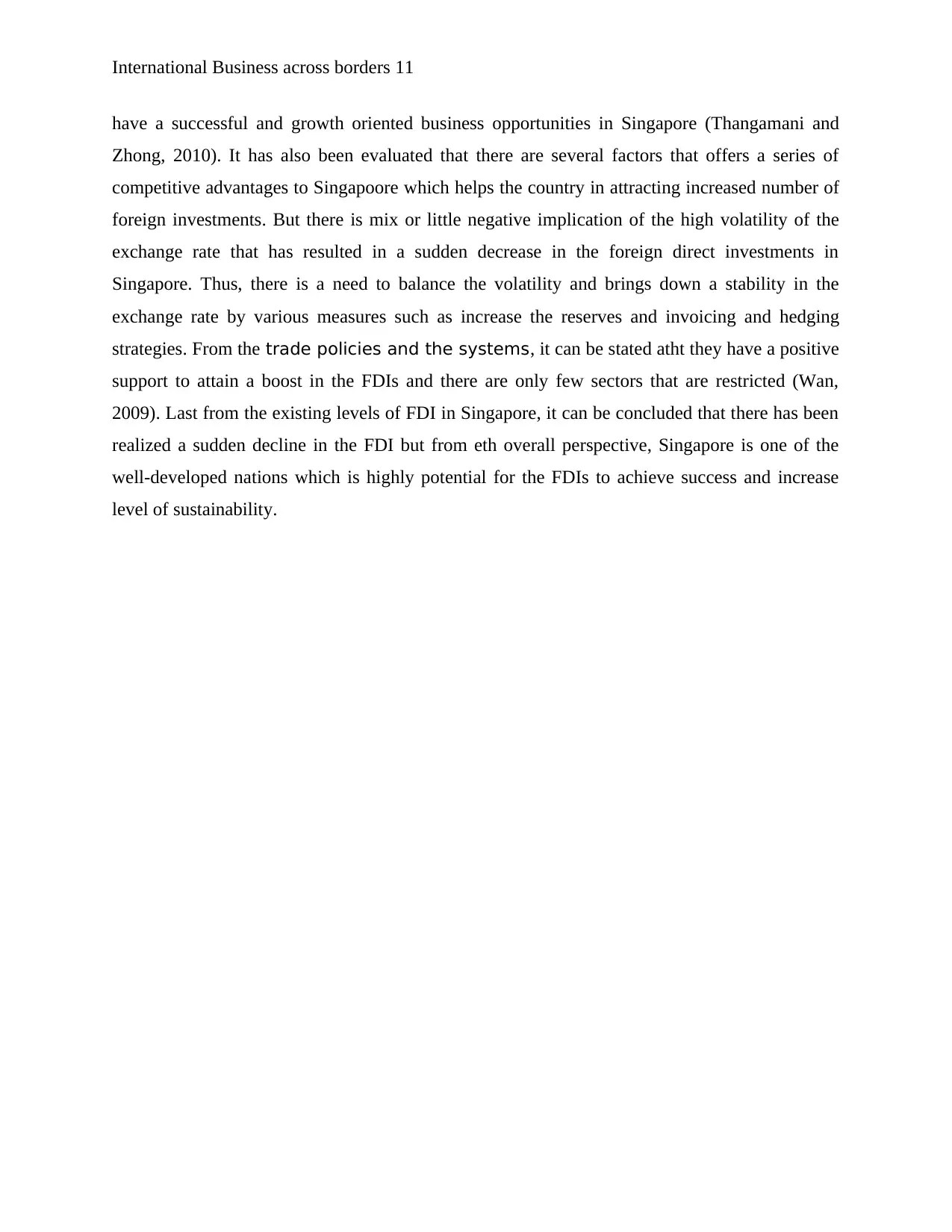
International Business across borders 11
have a successful and growth oriented business opportunities in Singapore (Thangamani and
Zhong, 2010). It has also been evaluated that there are several factors that offers a series of
competitive advantages to Singapoore which helps the country in attracting increased number of
foreign investments. But there is mix or little negative implication of the high volatility of the
exchange rate that has resulted in a sudden decrease in the foreign direct investments in
Singapore. Thus, there is a need to balance the volatility and brings down a stability in the
exchange rate by various measures such as increase the reserves and invoicing and hedging
strategies. From the trade policies and the systems, it can be stated atht they have a positive
support to attain a boost in the FDIs and there are only few sectors that are restricted (Wan,
2009). Last from the existing levels of FDI in Singapore, it can be concluded that there has been
realized a sudden decline in the FDI but from eth overall perspective, Singapore is one of the
well-developed nations which is highly potential for the FDIs to achieve success and increase
level of sustainability.
have a successful and growth oriented business opportunities in Singapore (Thangamani and
Zhong, 2010). It has also been evaluated that there are several factors that offers a series of
competitive advantages to Singapoore which helps the country in attracting increased number of
foreign investments. But there is mix or little negative implication of the high volatility of the
exchange rate that has resulted in a sudden decrease in the foreign direct investments in
Singapore. Thus, there is a need to balance the volatility and brings down a stability in the
exchange rate by various measures such as increase the reserves and invoicing and hedging
strategies. From the trade policies and the systems, it can be stated atht they have a positive
support to attain a boost in the FDIs and there are only few sectors that are restricted (Wan,
2009). Last from the existing levels of FDI in Singapore, it can be concluded that there has been
realized a sudden decline in the FDI but from eth overall perspective, Singapore is one of the
well-developed nations which is highly potential for the FDIs to achieve success and increase
level of sustainability.
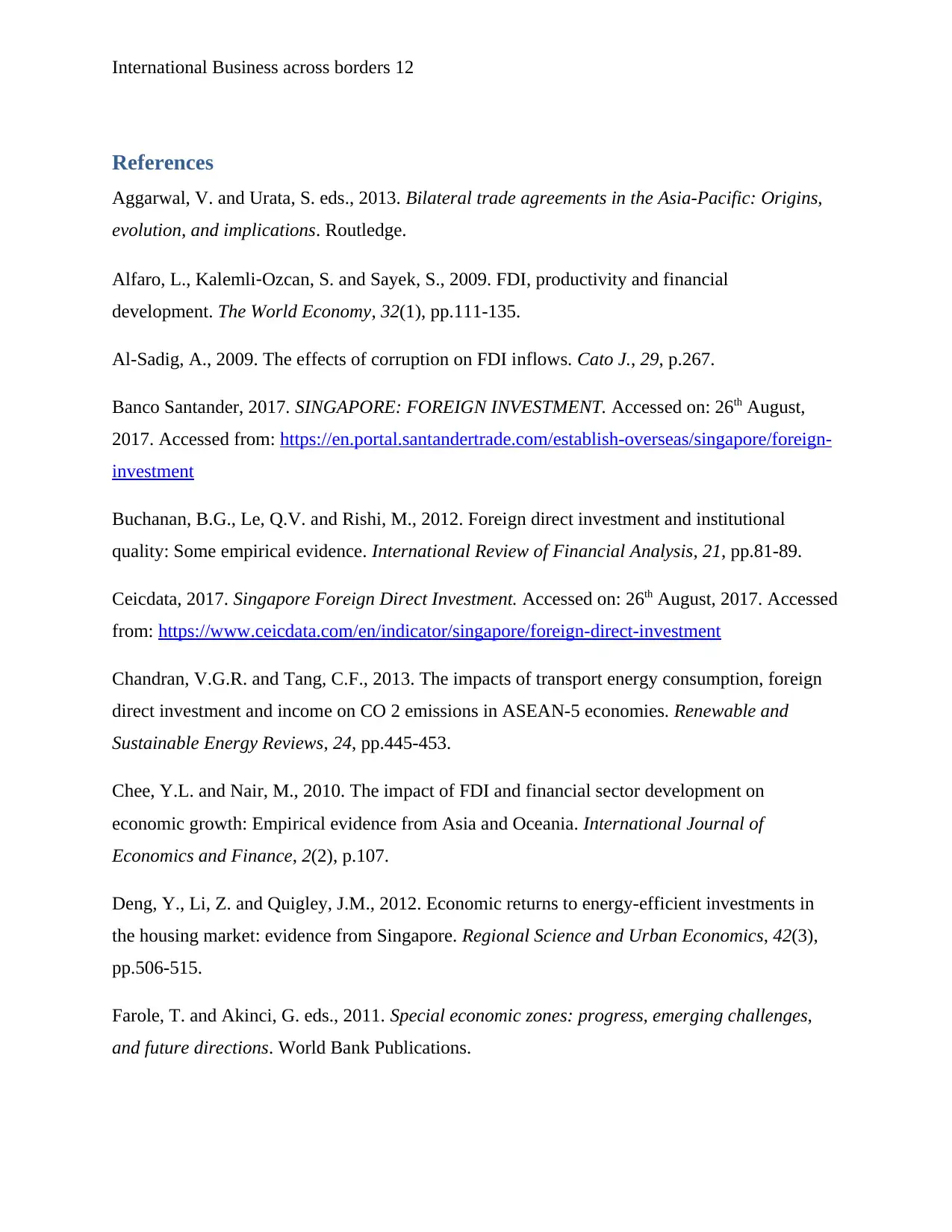
International Business across borders 12
References
Aggarwal, V. and Urata, S. eds., 2013. Bilateral trade agreements in the Asia-Pacific: Origins,
evolution, and implications. Routledge.
Alfaro, L., Kalemli‐Ozcan, S. and Sayek, S., 2009. FDI, productivity and financial
development. The World Economy, 32(1), pp.111-135.
Al-Sadig, A., 2009. The effects of corruption on FDI inflows. Cato J., 29, p.267.
Banco Santander, 2017. SINGAPORE: FOREIGN INVESTMENT. Accessed on: 26th August,
2017. Accessed from: https://en.portal.santandertrade.com/establish-overseas/singapore/foreign-
investment
Buchanan, B.G., Le, Q.V. and Rishi, M., 2012. Foreign direct investment and institutional
quality: Some empirical evidence. International Review of Financial Analysis, 21, pp.81-89.
Ceicdata, 2017. Singapore Foreign Direct Investment. Accessed on: 26th August, 2017. Accessed
from: https://www.ceicdata.com/en/indicator/singapore/foreign-direct-investment
Chandran, V.G.R. and Tang, C.F., 2013. The impacts of transport energy consumption, foreign
direct investment and income on CO 2 emissions in ASEAN-5 economies. Renewable and
Sustainable Energy Reviews, 24, pp.445-453.
Chee, Y.L. and Nair, M., 2010. The impact of FDI and financial sector development on
economic growth: Empirical evidence from Asia and Oceania. International Journal of
Economics and Finance, 2(2), p.107.
Deng, Y., Li, Z. and Quigley, J.M., 2012. Economic returns to energy-efficient investments in
the housing market: evidence from Singapore. Regional Science and Urban Economics, 42(3),
pp.506-515.
Farole, T. and Akinci, G. eds., 2011. Special economic zones: progress, emerging challenges,
and future directions. World Bank Publications.
References
Aggarwal, V. and Urata, S. eds., 2013. Bilateral trade agreements in the Asia-Pacific: Origins,
evolution, and implications. Routledge.
Alfaro, L., Kalemli‐Ozcan, S. and Sayek, S., 2009. FDI, productivity and financial
development. The World Economy, 32(1), pp.111-135.
Al-Sadig, A., 2009. The effects of corruption on FDI inflows. Cato J., 29, p.267.
Banco Santander, 2017. SINGAPORE: FOREIGN INVESTMENT. Accessed on: 26th August,
2017. Accessed from: https://en.portal.santandertrade.com/establish-overseas/singapore/foreign-
investment
Buchanan, B.G., Le, Q.V. and Rishi, M., 2012. Foreign direct investment and institutional
quality: Some empirical evidence. International Review of Financial Analysis, 21, pp.81-89.
Ceicdata, 2017. Singapore Foreign Direct Investment. Accessed on: 26th August, 2017. Accessed
from: https://www.ceicdata.com/en/indicator/singapore/foreign-direct-investment
Chandran, V.G.R. and Tang, C.F., 2013. The impacts of transport energy consumption, foreign
direct investment and income on CO 2 emissions in ASEAN-5 economies. Renewable and
Sustainable Energy Reviews, 24, pp.445-453.
Chee, Y.L. and Nair, M., 2010. The impact of FDI and financial sector development on
economic growth: Empirical evidence from Asia and Oceania. International Journal of
Economics and Finance, 2(2), p.107.
Deng, Y., Li, Z. and Quigley, J.M., 2012. Economic returns to energy-efficient investments in
the housing market: evidence from Singapore. Regional Science and Urban Economics, 42(3),
pp.506-515.
Farole, T. and Akinci, G. eds., 2011. Special economic zones: progress, emerging challenges,
and future directions. World Bank Publications.
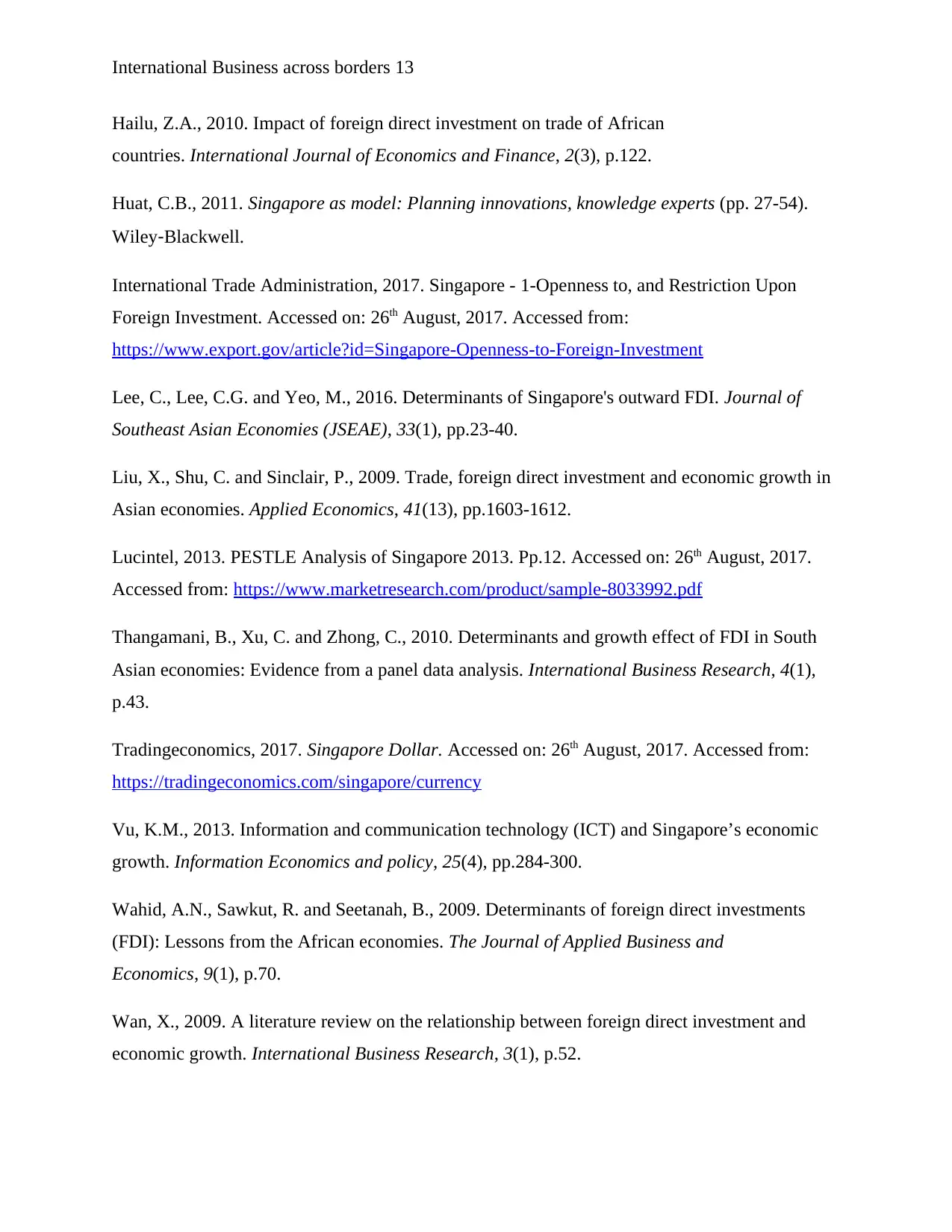
International Business across borders 13
Hailu, Z.A., 2010. Impact of foreign direct investment on trade of African
countries. International Journal of Economics and Finance, 2(3), p.122.
Huat, C.B., 2011. Singapore as model: Planning innovations, knowledge experts (pp. 27-54).
Wiley‐Blackwell.
International Trade Administration, 2017. Singapore - 1-Openness to, and Restriction Upon
Foreign Investment. Accessed on: 26th August, 2017. Accessed from:
https://www.export.gov/article?id=Singapore-Openness-to-Foreign-Investment
Lee, C., Lee, C.G. and Yeo, M., 2016. Determinants of Singapore's outward FDI. Journal of
Southeast Asian Economies (JSEAE), 33(1), pp.23-40.
Liu, X., Shu, C. and Sinclair, P., 2009. Trade, foreign direct investment and economic growth in
Asian economies. Applied Economics, 41(13), pp.1603-1612.
Lucintel, 2013. PESTLE Analysis of Singapore 2013. Pp.12. Accessed on: 26th August, 2017.
Accessed from: https://www.marketresearch.com/product/sample-8033992.pdf
Thangamani, B., Xu, C. and Zhong, C., 2010. Determinants and growth effect of FDI in South
Asian economies: Evidence from a panel data analysis. International Business Research, 4(1),
p.43.
Tradingeconomics, 2017. Singapore Dollar. Accessed on: 26th August, 2017. Accessed from:
https://tradingeconomics.com/singapore/currency
Vu, K.M., 2013. Information and communication technology (ICT) and Singapore’s economic
growth. Information Economics and policy, 25(4), pp.284-300.
Wahid, A.N., Sawkut, R. and Seetanah, B., 2009. Determinants of foreign direct investments
(FDI): Lessons from the African economies. The Journal of Applied Business and
Economics, 9(1), p.70.
Wan, X., 2009. A literature review on the relationship between foreign direct investment and
economic growth. International Business Research, 3(1), p.52.
Hailu, Z.A., 2010. Impact of foreign direct investment on trade of African
countries. International Journal of Economics and Finance, 2(3), p.122.
Huat, C.B., 2011. Singapore as model: Planning innovations, knowledge experts (pp. 27-54).
Wiley‐Blackwell.
International Trade Administration, 2017. Singapore - 1-Openness to, and Restriction Upon
Foreign Investment. Accessed on: 26th August, 2017. Accessed from:
https://www.export.gov/article?id=Singapore-Openness-to-Foreign-Investment
Lee, C., Lee, C.G. and Yeo, M., 2016. Determinants of Singapore's outward FDI. Journal of
Southeast Asian Economies (JSEAE), 33(1), pp.23-40.
Liu, X., Shu, C. and Sinclair, P., 2009. Trade, foreign direct investment and economic growth in
Asian economies. Applied Economics, 41(13), pp.1603-1612.
Lucintel, 2013. PESTLE Analysis of Singapore 2013. Pp.12. Accessed on: 26th August, 2017.
Accessed from: https://www.marketresearch.com/product/sample-8033992.pdf
Thangamani, B., Xu, C. and Zhong, C., 2010. Determinants and growth effect of FDI in South
Asian economies: Evidence from a panel data analysis. International Business Research, 4(1),
p.43.
Tradingeconomics, 2017. Singapore Dollar. Accessed on: 26th August, 2017. Accessed from:
https://tradingeconomics.com/singapore/currency
Vu, K.M., 2013. Information and communication technology (ICT) and Singapore’s economic
growth. Information Economics and policy, 25(4), pp.284-300.
Wahid, A.N., Sawkut, R. and Seetanah, B., 2009. Determinants of foreign direct investments
(FDI): Lessons from the African economies. The Journal of Applied Business and
Economics, 9(1), p.70.
Wan, X., 2009. A literature review on the relationship between foreign direct investment and
economic growth. International Business Research, 3(1), p.52.
Paraphrase This Document
Need a fresh take? Get an instant paraphrase of this document with our AI Paraphraser

International Business across borders 14
Woo, J., 2009. Productivity growth and technological diffusion through foreign direct
investment. Economic Inquiry, 47(2), pp.226-248.
Woo, J., 2009. Productivity growth and technological diffusion through foreign direct
investment. Economic Inquiry, 47(2), pp.226-248.
1 out of 14
Related Documents
Your All-in-One AI-Powered Toolkit for Academic Success.
+13062052269
info@desklib.com
Available 24*7 on WhatsApp / Email
![[object Object]](/_next/static/media/star-bottom.7253800d.svg)
Unlock your academic potential
© 2024 | Zucol Services PVT LTD | All rights reserved.





